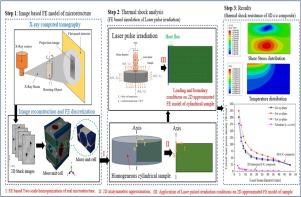Materials Today Communications ( IF 3.8 ) Pub Date : 2020-09-10 , DOI: 10.1016/j.mtcomm.2020.101637 Mohammad Zahid , Rajneesh Sharma

|
The thermal shock resistance of the 4D-inplane carbon/carbon composite has been predicted using the simulations of the laser irradiation test. Firstly, the effective homogenized temperature dependent properties of the carbon/carbon (c/c) composite have been predicted using realistic unit cell. The meso-scale unit cell has been reconstructed using the reconstructed images of the composite obtained through X-Ray computed tomography. The meso unit cell includes the realistic microstructural features such as fiber bundle distortions and irregular shaped big voids in the geometry. The bundles of the reconstructed unit cell are further considered as a unidirectional composite and micro unit cells are utilized to define their effective behavior. Two-scale asymptotic expansion homogenization method has been used along with finite element method and periodic boundary conditions for the prediction of effective properties. Later, thermo-mechanical transient two-dimensional analysis of a cylindrical specimen has been conducted. The irradiation laser beam parameters e.g. diameters of beam and heat flux have been varied to study the critical values of laser power density (LPD). The maximum shear strength failure criterion is used to define the ultimate state. The obtained trend of the variation of LPD is validated using the data available in the literature for 2D C/C composites. It has been observed that the present results are in good agreement with those existing in the literature. The thermal shock resistant capability of 4DIN C/C composite is found around 10–18 times higher than that of 2D C/C composite.
中文翻译:

基于微观结构有效特性的4D平面碳/碳复合材料的抗热震性
使用激光辐照试验的模拟可以预测4D平面碳/碳复合材料的耐热冲击性。首先,已经使用实际的晶胞预测了碳/碳(c / c)复合材料的有效均质温度依赖性。使用通过X射线计算机断层扫描获得的复合材料的重建图像,重建了中尺度单位晶胞。中观晶胞包括现实的微观结构特征,例如纤维束变形和几何形状中不规则形状的大空隙。重建后的晶胞的束被进一步视为单向复合材料,而微晶胞则被用来定义其有效行为。两尺度渐近展开均匀化方法与有限元方法和周期边界条件一起用于预测有效性质。后来,对圆柱试样进行了热机械瞬态二维分析。改变了照射激光束参数,例如束直径和热通量,以研究激光功率密度(LPD)的临界值。最大抗剪强度破坏准则用于定义极限状态。使用2D C / C复合材料的文献中可用的数据验证了LPD变化的趋势。已经观察到,目前的结果与文献中已有的结果非常一致。

























 京公网安备 11010802027423号
京公网安备 11010802027423号